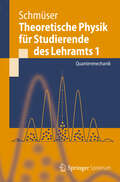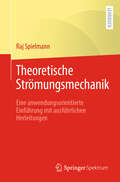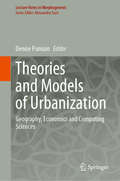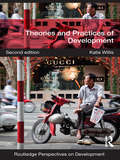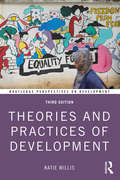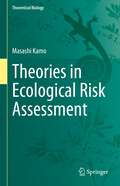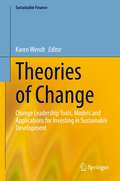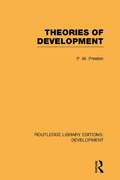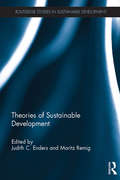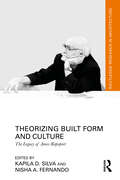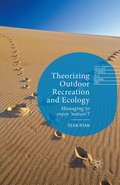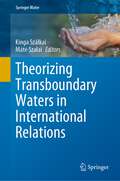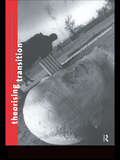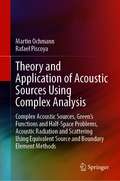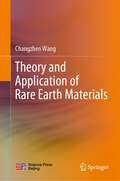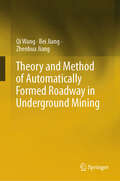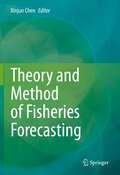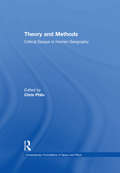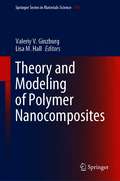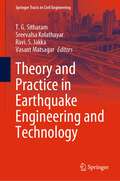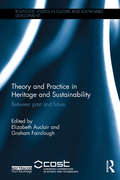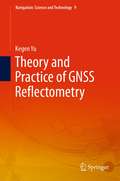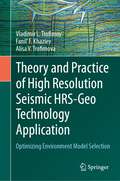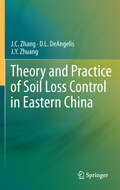- Table View
- List View
Theoretische Physik für Studierende des Lehramts 2
by Peter SchmüserDas zweibändige Lehrbuch vermittelt die Grundlagen der theoretischen Physik und berücksichtigt dabei besonders die Quantenmechanik, die spezielle Relativitätstheorie und die Elektrodynamik für den Unterricht an Gymnasien. Band 2 bietet eine systematische Einführung in die Elektrodynamik auf Basis der Maxwellschen Gleichungen sowie eine Einführung in die relativistische Mechanik. Der Stoff wird einfach und klar dargestellt, Abbildungen und didaktische Anmerkungen erleichtern den Zugang zur Theorie und geben Hinweise für die Vermittlung im Unterricht.
Theoretische Strömungsmechanik: Eine anwendungsorientierte Einführung mit ausführlichen Herleitungen
by Raj SpielmannDas Buch bietet einen didaktisch ausgearbeiteten Einstieg in die theoretische Strömungsmechanik und gibt gleichzeitig Einblicke in die Vielfalt ihrer Anwendungen in Natur und Technik. Der Schwerpunkt liegt auf der Aerodynamik für niedrigere Fluggeschwindigkeiten, die unvermindert von hohem praktischen Wert ist, jedoch in der Einführungsliteratur meist zu kurz kommt. Bei den Herleitungen wird darauf Wert gelegt, die entsprechenden Begriffe und Zusammenhänge zu veranschaulichen. Damit richtet sich der Text in erster Linie an Studierende der Mathematik, die eine Brücke zu ingenieurtechnischen Anwendungen suchen. Ebenso sollte er für Ingenieure nützlich sein, die sich für die Herleitung der Formeln und Hintergründe interessieren. Zur lückenlosen Verständlichkeit wurden zahlreiche Zwischenschritte beim Rechnen, die für gewöhnlich dem Leser überlassen werden, in Aufgaben verpackt. Ergänzt durch Fragen zum Konzeptverständnis werden sie im Lösungsteil nachgerechnet. Damit bleibt die Darstellung für einen breiten Interessentenkreis von Nutzen.
Theories and Models of Urbanization: Geography, Economics and Computing Sciences (Lecture Notes in Morphogenesis)
by Denise PumainThis book provides a thorough discussion about fundamental questions regarding urban theories and modeling. It is a curated collection of contributions to a workshop held in Paris on October 12th and 13th 2017 at the Institute of Complex Systems by the team of ERC GeoDiverCity. There are several chapters conveying the answers given by single authors to problems of conceptualization and modeling and others in which scholars reply to their conception and question them. Even, the chapters transcribing keynote presentations were rewritten according to contributions from the respective discussions. The result is a complete “state of the art” of what is our knowledge about urban processes and their possible formalization.
Theories and Practices of Development (Routledge Perspectives on Development)
by Katie WillisGlobal economic crisis and the implications of global environmental change have led academics and policy-makers to consider how 'development' in all parts of the world should be achieved. However, 'development' has always been a contested idea. While often presented as a positive process to improve people's lives, the potential negative dimensions of 'development' on people and environments must also be recognized. Theories and Practices of Development provides a clear and user-friendly introduction to the complex debates around how development has been understood and achieved. The second edition has been fully updated and expanded to reflect global political and economic shifts, as well as new approaches to development. The rise of China and India is given particular attention, as is the global economic crisis and its implications for development theories and practice. There are new sections on faith-based development, and the development dimensions of climate change, as well as greater engagement with development theories as they are put into practice in the Global North. The book deals with the evolution of development ideas and policies, focusing on economic, political, social, environmental and spatial dimensions. It highlights how development cannot be considered as a neutral concept, but is entwined with inequalities in power at local, as well as national and global scales. The use of boxed examples, tables and illustrations helps students understand complex theoretical ideas and also demonstrates how development theories are put into practice in the real world. Each chapter ends with a summary section, discussion topics, suggestions for further reading and website resources.
Theories and Practices of Development (Routledge Perspectives on Development)
by Katie WillisThe newly updated third edition provides a clear and user-friendly introduction to the complex debates around how development has been understood and achieved. It has been fully updated and expanded to reflect global political and economic shifts, as well as new approaches to development. The book deals with the evolution of development ideas and policies, focusing on economic, political, social, environmental and spatial dimensions. It highlights how development cannot be considered as a neutral concept, but is entwined with inequalities in power at local as well as national and global scales. A new chapter on politics and development presents debates around development and democracy, civil society organizations and human rights. Sections on diversity and development have been expanded, and the book considers the future of development in the era of the Sustainable Development Goals (SDGs). The use of boxed examples, tables and illustrations helps students understand complex theoretical ideas and also demonstrates how development theories are put into practice in the real world. Each chapter ends with a summary section, discussion topics, suggestions for further reading and website resources. This key text provides a clear and thorough explanation of key development theories and practices. The third edition will remain an invaluable resource for undergraduate students in geography, politics and development studies.
Theories in Ecological Risk Assessment (Theoretical Biology)
by Masashi KamoThis book introduces various mathematical models used in ecological risk assessment, primarily discussing models used in hazard assessment. The book aims to link ecology and conservation biology with risk assessments, bringing together the knowledge of ecotoxicology and ecology for effective risk assessment. The first part describes population-level assessment in ecological risk assessment. The chapters cover current methodologies for ecological risk assessment, individual-level assessment, population dynamics models for population-level assessment, case studies, mathematical models for population extinctions, the derivation of mean time to extinction (MTE) and their case studies. The second part of the book discusses the mathematical models involved in hazard assessments. It introduces the method of risk assessment using species sensitivity distributions (SSDs), hazard assessment of metals, chemical mixtures using the Michaelis-Menten equation, basic elements of statistics and related topics. Expected readers are risk assessors in governments and public sectors, students and young researchers interested in environmental science. The book is made accessible and easy to follow by beginners in mathematical biology and theoretical ecology.
Theories of Change: Change Leadership Tools, Models and Applications for Investing in Sustainable Development (Sustainable Finance)
by Karen WendtToday, it has become strikingly obvious that companies no longer operate in an environment where only risk return and volatility describe the business environment. The business has to deal with volatility plus uncertainty, plus complexity and ambiguity (VUCA): that requires new qualities, competencies, frameworks; and it demands a new mind set to deal with the VUCA environment in investment, funding and financing. This book builds on a new megatrend beyond resilience, called anti-fragility. We have had the black swan (financial crisis) and the red swan (COVID) - the Bank for International Settlement is preparing for regenerative capitalism, block chain based analysis of financial streams and is aiming to prevent the “Green Swan” – the climate crisis to lead to the next lockdown. In the light of the UN 17 Sustainable Development Goals, what is required, is Theories of Change.Written by experts working in the fields of sustainable finance, impact investing, development finance, carbon divesting, innovation, scaling finance, impact entrepreneurship, social stock exchanges, alternative currencies, Initial Coin Offerings (ICOs), ledger technologies, civil action, co-creation, impact management, deep learning and transformation leadership, the book begins by analysing existing Theories of Change frameworks from various disciplines and creating a new integrated model – the meta-framework. In turn, it presents insights on creating and using Theories of Change to redirect investment capital to sustainable companies while implementing the Sustainable Development Goals and the Paris Climate Agreement. Further, it discusses the perspective of planetary boundaries as defined by the Stockholm Resilience Institute, and investigates various aspects of systems, organizations, entrepreneurship, investment and finance that are closely tied to the mission ingrained in the Theory of Change. As it demonstrates, solutions that ensure the parity of profit, people and planet through dynamic change can effectively address the needs of entrepreneurs and business. By exploring these concepts and their application, the book helps create and shape new markets and opportunities.
Theories of Development: An Introduction To Classical And Contemporary Theories Of Development And Their Application To Southeast Asia (Routledge Library Editions: Development)
by Peter PrestonDr Preston’s book, first published in 1982, presents a critical history of development studies since the Second World War, linking the recent, neo-Marxist, debate with the whole tradition in the field, going back to the work of economists like Arthur Lewis. He identifies a series of ‘schools’ and evaluates their contribution, supplying in each case a careful analysis, informed by the sociology of knowledge, of the work of its leading theorists. His final assessment draws on the critical theory of Habermas, arguing that social theorising is essentially practical; a matter of the construction, criticism and comparative ranking of ideologies, and that theorists should therefore consider what it makes sense for them to do or say, given their circumstances and the problems they address.
Theories of Sustainable Development (Routledge Studies in Sustainable Development)
by Judith C. Enders Moritz RemigWhile sustainability has become a buzzword in discussions about the environment and development, work on theories of sustainable development has received much less attention. However, theory is vital as understanding the origins and development of the concept is the key to achieving successful implementation of sustainability. This book offers an interdisciplinary collection of research articles on the theories of sustainable development, drawing on a wide range of subjects including history, politics, governance, complex systems, economics and philosophy. It advocates viewing sustainable development not only as the establishment of a permanent, globally practicable and future-capable mode of life and economics, but as a complex array of problems involving a wide range of social-scientific and humanistic disciplines. This innovative approach means that the book is oriented toward current problems, not toward the established academic boundaries, and it draws out lessons that are relevant for those studying and working in sustainability across the world. This book will be of great interest to researchers and students of sustainable development and environmental politics, as well as practitioners working with sustainable development in politics, business, administration, and civil society organizations.
Theorizing Built Form and Culture: The Legacy of Amos Rapoport (Routledge Research in Architecture)
by Kapila D. Silva Nisha A. FernandoIn this collection of essays, Theorizing Built Form and Culture: The Legacy of Amos Rapoport – a felicitation volume to celebrate the significance of Professor Amos Rapoport's lifelong scholarship – scholars from around the world discuss the analytical relevance, expansion, and continuing application of these contributions in developing an advanced understanding of mutual relationships between people and built environments across cultures.Professor Amos Rapoport has espoused an intellectual and theoretical legacy on environmental design scholarship that explains how cultural factors play a significant role in the ways people create and use environments as well as the way environments, in turn, influence people’s behavior. This volume presents a hitherto-not-seen, unique, and singular work that simultaneously articulates a cohesive framework of Rapoport’s architectural theories and demonstrates how that theoretical approach be used in architectural inquiry, education, and practice across environmental scales, types, and cultural contexts. It also acknowledges, for the very first time, how this theoretical legacy has pioneered the decolonizing of the Eurocentric approaches to architectural inquiry and has thus privileged an inclusive, cross-cultural perspective that laid the groundwork to understand and analyze non-Western design traditions. The book thus reflects a wide range of cross-cultural and cross-contextual range to which Professor Rapoport’s theories apply, a general notion of theoretical validity he always advocated for in his own writings.The volume is a paramount source for scholars and students of architecture who are interested in understanding how culture mediates the creation, use, and preservation of the built environment.
Theorizing Outdoor Recreation and Ecology (Leisure Studies in a Global Era)
by Sean RyanDeciding what user impacts are natural or unnatural has inspired much debate. Biophysically, moose cause similar kinds of soil and vegetation impacts as hikers. Yet moose are the sign of nature while hikers are the sign of damage. The field of outdoor recreation is beset with paradoxes, and this book presents a unique, alternative framework to address these dilemmas. Examining outdoor recreation through the lens of ecological theory, Ryan draws from theorists such as Foucault, Derrida and Latour. The book explores minimum impact strategies designed to protect and enhance ecological integrity, but that also require a disturbing amount of policing of users, which runs counter to the freedom users seek. Recent ecological theory suggests that outdoor recreation's view of nature as balanced when impacts are removed is outdated and incorrect. What is needed, and indeed Ryan presents, is a paradoxical and ecological view of humans as neither natural nor unnatural, a view that embraces some traces in nature.
Theorizing Transboundary Waters in International Relations (Springer Water)
by Máté Szalai Kinga SzálkaiThis book is the first collection of state-of-the-art research projects analyzing water conflict and cooperation with an explicitly theoretical point of view. Its fourteen chapters offer a comprehensive and up-to-date overview on how the application of various theoretical perspectives can support the work of scholars and practitioners in mitigating water conflict and developing cooperation.The volume starts out from a literature review on the theorization of transboundary waters in International Relations, which prepares the ground for the demonstration of the latest approaches of scholars currently working on this field. The discussion of their findings is divided into four main sections. The first section deals with reflections and critiques on the grand theories of International Relations, proposing new and more nuanced frameworks for understanding and managing transboundary water relations by going beyond the traditional assumptions. The second section focuses on the catalysts and barriers of cooperation, applying theoretical frameworks which reveal the consequences of the dynamics in power relations and institutional frameworks. The third section investigates into the perspectives at the intersections of theory and practice related to the most practical field within the scope of the volume: water diplomacy. The fourth section introduces new perspectives to provide specific entry points for understanding and managing water conflict and cooperation.Overall, the work intends to demonstrate that the theorization of transboundary waters can significantly contribute to the deeper understanding and the more efficient management of water conflicts and cooperation from several aspects.The authors come from diverse backgrounds, and their individual careers are often related to the intersections of theory and practice in the field of transboundary water management. Their expertise covers water issues from all around the globe, which is reflected in the range of the analyzed case studies. The diversity of the experts involved, their backgrounds, their perspectives, the applied theories, and the analyzed cases was an important priority for the editors.
Theorizing Transition: The Political Economy of Post-Communist Transformations
by Adrian Smith John PicklesTheorizing Transition provides a comprehensive examination of the economic, political, social and cultural transformations in post-Communist countries and an important critique of transition theory and policy. The authors create the basis of a theoretical understanding of transition in terms of a political economy of capitalist development. The diversity of forms and complexities of transition are examined through a wide range of examples from post-Soviet countries and comparative studies from countries such as Vietnam and China. Theorizing Transition challenges many of the comfortable assumptions unleashed by the euphoria of democratisation and the triumphalism of market capitalism in the early 1990s and shows transition to be much more complex than mainstream theory suggests.
Theory and Application of Acoustic Sources Using Complex Analysis: Complex Acoustic Sources, Green’s Functions and Half-Space Problems, Acoustic Radiation and Scattering Using Equivalent Source and Boundary Element Methods
by Martin Ochmann Rafael PiscoyaThis book highlights the mathematical and physical properties of acoustical sources with singularities located in the complex plane and presents the application of such special elements to solve acoustical radiation and scattering problems. Sources whose origin lies in the complex plane are also solutions of the wave equation but possess different radiating properties as their counterparts with real positions. Such mathematical constructions are known in the fields of optics and electrodynamics, but they are not common in acoustical research. The objective of the book is to introduce this concept to acousticians and motivate them to engage themselves in further research and application of complex sources. Such sources are particularly useful to formulate Green’s functions and related equivalent source and boundary element methods in half-spaces.
Theory and Application of Rare Earth Materials
by Changzhen WangThis book starts with a theoretical introduction of the rare earth materials, and it subsequently analyzes the essential characteristics of these materials from elements, compounds to physical chemistry and metal materials, etc. Under the supplementary explanation of experimental data and results, the research is gradually guided into the multi-domain application scene. Through extensive analyses, this book displays comprehensively the distinguished values of the rare earth materials and the theoretical, empirical, and practical significance of rare earth materials is unraveled. It also covers an exhaustive review of 17 rare earth elements, their characteristics, and more possibilities in physical chemistry, functional materials, metallurgy, composites and engineering, and their prospects in production and technical applications. In-depth account of the whole spectrum of rare earth material research makes this book a unique reference to academic researchers, students, and engineers.
Theory and Method of Automatically Formed Roadway in Underground Mining
by Qi Wang Bei Jiang Zhenhua JiangThis book investigates in detail the theory and method of automatically formed mining roadway (AFR). The AFR method utilizes mining pressure and broken expansion characteristics of the collapsed rock mass in the gob to automatically form roadways, which changes the traditional “long cantilever beam” to “short cantilever beam” structure, and eliminate roadway excavation and coal pillar reserve. Key technologies are developed under the guidance of the “equilibrium mining” theory, such as in situ drilling and zoning technology, roof directional presplitting technology, high prestressed constant-resistance support technology, and gangue blocking support technology. The mining technologies and methods are successfully applied to a large number of coal mines of different geological conditions. The book is intended for both researchers and practitioners working in the mining, civil, and geological engineering fields.
Theory and Method of Fisheries Forecasting
by Xinjun ChenThis book systematically introduces the knowledge system and research results of fisheries forecasting. It is divided into four parts and seven chapters. The first part is the introduction, which mainly introduces the basic concepts, the nature of the subject, and the research contents, as well as the current status of research. The second part is about the basic knowledge of fisheries forecasting, including overview of the world marine environment, fish shoaling and migration distribution, the relationship between fish behavior and marine environment, and the basic theory of forming fishing ground. The third part is the focus of this book, including the basic principles and methods of fisheries forecasting, as well as the application of new techniques and methods in fisheries forecasting. The fourth part is the comprehensive application of fisheries forecasting, including the general situation of world marine fisheries, the impact of global marine environment changes on fisheries resources and fishing ground, and case studying of fisheries forecasting of important economic species, such as oceanic squid, jack mackerel, anchovy, and skipjack. The study of this book will help everyone to master the basic principles and methods of fisheries forecasting, as well as the application of new technologies and methods in important economic species, and lay a foundation for future work in the field of marine fisheries.
Theory and Methods: Critical Essays in Human Geography (Contemporary Foundations of Space and Place)
by Chris PhiloThis volume tackles the complex terrain of theory and methods, seeking to exemplify the major philosophical, social-theoretic and methodological developments - some with clear political and ethical implications - that have traversed human geography since the era of the 1960s when spatial science came to the fore. Coverage includes Marxist and humanistic geographies, and their many variations over the years, as well as ongoing debates about agency-structure and the concepts of time, space, place and scale. Feminist and other 'positioned' geographies, alongside poststructuralist and posthumanist geographies, are all evidenced, as well as writings that push against the very 'limits' of what human geography has embraced over these fifty plus years. The volume combines readings that are well-known and widely accepted as 'classic', with readings that, while less familiar, are valuable in how they illustrate different possibilities for theory and method within the discipline. The volume also includes a substantial introduction by the editor, contextualising the readings, and in the process providing a new interpretation of the last half-century of change within the thoughts and practices of human geography.
Theory and Modeling of Polymer Nanocomposites (Springer Series in Materials Science #310)
by Valeriy V. Ginzburg Lisa M. HallThis edited volume brings together the state of the art in polymer nanocomposite theory and modeling, creating a roadmap for scientists and engineers seeking to design new advanced materials. The book opens with a review of molecular and mesoscale models predicting equilibrium and non-equilibrium nanoscale structure of hybrid materials as a function of composition and, especially, filler types. Subsequent chapters cover the methods and analyses used for describing the dynamics of nanocomposites and their mechanical and physical properties. Dedicated chapters present best practices for predicting materials properties of practical interest, including thermal and electrical conductivity, optical properties, barrier properties, and flammability. Each chapter is written by leading academic and industrial scientists working in each respective sub-field. The overview of modeling methodology combined with detailed examples of property predictions for specific systems will make this book useful for academic and industrial practitioners alike.
Theory and Practice in Earthquake Engineering and Technology (Springer Tracts in Civil Engineering)
by Vasant Matsagar T. G. Sitharam Sreevalsa Kolathayar Ravi S. JakkaThis book contains diverse topics relevant to earthquake engineering and technology. The chapters are of interest to readers from various disciplines, as the different chapters discuss popular topics on earthquake engineering and allied disciplines. The chapters have adequate illustrations and tables for clarifying underlying concepts. The reader can understand the fundamental concepts easily, and the book is highly useful for practice in the field in addition to classroom learning.
Theory and Practice in Heritage and Sustainability: Between past and future (Routledge Studies in Culture and Sustainable Development)
by Elizabeth Auclair and Graham FaircloughThis book explores cultural sustainability and its relationships to heritage from a wide interdisciplinary perspective. By examining the interactions between people and communities in the places where they live it exemplifies the diverse ways in which a people-centred heritage builds identities and supports individual and collective memories. It encourages a view of heritage as a process that contributes through cultural sustainability to human well-being and socially- and culturally-sensitive policy. With theoretically-informed case studies from leading researchers, the book addresses both concepts and practice, in a range of places and contexts including landscape, townscape, museums, industrial sites, every day heritage, ‘ordinary’ places and the local scene, and even UNESCO-designated sites. The contributors, most of whom, like the editors, were members of the COST Action ‘Investigating Cultural Sustainability’, demonstrate in a cohesive way how the cultural values that people attach to place are enmeshed with issues of memory, identity and aspiration and how they therefore stand at the centre of sustainability discourse and practice. The cases are drawn from many parts of Europe, but notably from the Baltic, and central and south-eastern Europe, regions with distinctive recent histories and cultural approaches and heritage discourses that offer less well-known but transferable insights. They all illustrate the contribution that dealing with the inheritance of the past can make to a full cultural engagement with sustainable development. The book provides an introductory framework to guide readers, and a concluding section that draws on the case studies to emphasise their transferability and specificity, and to outline the potential contribution of the examples to future research, practice and policy in cultural sustainability. This is a unique offering for postgraduate students, researchers and professionals interested in heritage management, governance and community participation and cultural sustainability.
Theory and Practice of Dialogical Community Development: International Perspectives
by Peter Westoby Gerard DowlingThis book proposes that community development has been increasingly influenced and co-opted by a modernist, soulless, rational philosophy - reducing it to a shallow technique for ‘solving community problems’. In contrast, this dialogical approach re-maps the ground of community development practice within a frame of ideas such as dialogue, hospitality and depth. For the first time community development practitioners are provided with an accessible understanding of dialogue and its relevance to their practice, exploring the contributions of internationally significant thinkers such as P. Freire, M. Buber, D. Bohm and H.G Gadamer, J. Derrida, G. Esteva and R. Sennett. What makes the book distinctive is that: first, it identifies a dialogical tradition of community development and considers how such a tradition shapes practice within contemporary contexts and concerns – economic, social, political, cultural and ecological. Second, the book contrasts such an approach with technical and instrumental approaches to development that fail to take complex systems seriously. Third, the approach links theory to practice through a combination of storytelling and theory-reflection – ensuring that readers are drawn into a practice-theory that they feel increasingly confident has been 'tried and tested' in the world over the past 25 years.
Theory and Practice of GNSS Reflectometry (Navigation: Science and Technology #9)
by Kegen YuThis is the first authored English book completely focused on global navigation satellite system reflectometry (GNSS-R). It consists of two main parts: the fundamental theory; and major applications, which include ocean altimetry, sea surface wind speed retrieval, snow depth measurement, soil moisture measurement, tsunami detection and sea ice detection. Striking a healthy balance between theory and practice, and featuring in-depth studies and extensive experimental results, the book introduces beginners to the fundamentals, while preparing experienced researchers to pursue advanced investigations and applications in GNSS-R.
Theory and Practice of High Resolution Seismic HRS-Geo Technology Application: Optimizing Environment Model Selection
by Vladimir L. Trofimov Alisa V. Trofimova Fanil' F. KhazievThis book outlines the scientific, methodological and practical foundations for applying High Resolution Seismic HRS-Geo Technology in order to build detailed 2D and 3D seismic acoustic models in the form of acoustic impedances (AI) and reflection coefficients (RC) and the most important geological indicators. The monograph is a continuation of the book by the same authors "Oil and Gas Reservoir Prospecting and Exploration: High-Resolution Seismic HRS techniques and technology".Particular attention is paid to improving the process of searching for AI and RC models using the vector of objective functions, in which various types of residuals between real and model data are iteratively calculated. The well-known criteria for predicting the oil and gas potential of productive deposits from the standpoint of the system analysis principles and the set of geological indicators found from the HRS data are analyzed. The features of solving the main seismogeological problems using HRS-Geo Technology modules are shown, illustrated by numerous examples, and using a special (optimal) processing graph and a set of additional seismic record regularization procedures that provide maximum detail of high-resolution seismic data. The book is meant for scientists and specialists involved in in-depth complex geological interpretation of seismic data in the search and exploration of oil and gas deposits, as well as students of geophysical and geological specialties, graduate students of these specializations and developers.
Theory and Practice of Soil Loss Control in Eastern China
by J. C. Zhang J. Y. Zhuang D. L. DeangelisAfter the 1998 flood of the Yangtze River, one of the world's most important rivers, environmental experts realized that, to control flooding, much more attention must be paid to vegetation cover on bare lands, thin forest land, and shrub-covered land in mountain areas. In 1999, an environmental monitoring project of the forests in 11 provinces of the Yangtze River basin was undertaken. This book reports on soil loss prediction and the successful practices of soil loss control in eastern China in recent years.
